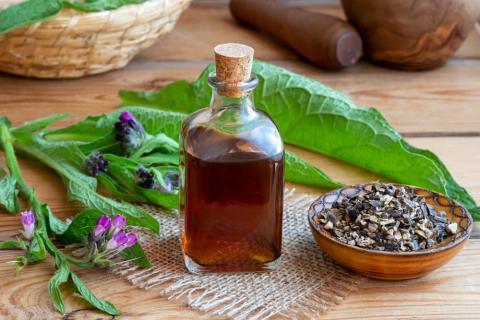
Incorporating herbs into your lifestyle can take many forms, from cooking with essential oils to making your own body scrubs and lips balms. If you wish to begin making your own creams, balms, and salves, you will need to start by building a pantry of infused oils that add to the beneficial effects of your products. There are thousands of useful herbs on the planet, and it can be intimidating to try to get to know any of them. Here I would like to provide you with a simple list of six plants that are most commonly and effectively used in infused oils.
Calendula
Calendula is a bright orange flower with a concentrated center of petals. The outer petal resembles those of a daisy. The flower grows a resin on its underside, which contains the medicinal qualities of the plant.
- Best Use: Calendula is best used as a skin soothing and brightening herb. I like to use it as a base for face creams, oils, cuticle salve, or lip balms.
- Also Great For: Facial steams.
Comfrey
Some consider comfrey a weed, but it is one of the most useful plants that can be found in the garden. Its prolific roots send up a series of wide, hairy, and veiny leaves in a group that are used to make rich compost, feed chickens, and heal bumps and bruises. Historically, comfrey was known as the bone-mending herb and was used as a poultice on broken bones.
- Best Use: Comfrey has powerful restoring qualities and should be used in the base oil for a variety of salves aimed at healing bruises, sprains, strains, and fractures.
- Also Great For: Poultices.
Plantain
Plantain can be found growing on almost every continent and is an extremely common weed in yards. Its wide, oval-shaped leaves grow up from the ground in a circle and have long veins running parallel to the edges. It was commonly used as a poultice on open wounds to help fight and prevent infection.
- Best Use: Plantain has been used traditionally to ward off bacterial infection and is best used in a salve to make a homemade antibiotic ointment.
- Also Great For: Poultices and cleaning facial steams, especially to treat acne.
Lavender
Lavender has been used for hundreds of years, starting in the Mediterranean for its incredible aromatic qualities. It gets its name from the Latin lavare which means to wash and it has been used in various cleaning products for generations.
- Best Use: Besides its aromatic qualities, lavender has relaxing and healing qualities that make it ideal for an infused massage oil or as addition to a plantain-based antibiotic ointment.
- Also Great For: Salt scrubs, facial steams, vinegar rinses, culinary accents.
Arnica
Originally used in the mountains of Europe and North America, arnica has quickly become one of the most well-known homeopathic pain relievers on the modern market. Arnica-infused pastilles are taken orally to help reduce inflammation from the inside out, but arnica infused creams are also commonly used. You can easily make your own arnica healing salve at home when you infuse an oil with this magical flower.
- Best Use: Arnica should be used in the base oil of a salve, cream, or ointment that is specifically aimed at muscle and soft tissue recovery. It is commonly used on bruises but is most effective on strained and sore muscles.
- Also Great For: Facial steams, cleansing rinses.
Turmeric
Another favorite of the modern market, turmeric is commonly taken in tandem with cayenne via capsules to assist in the reduction of joint inflammation and arthritis. It is a popular culinary herb and can be ingested in a variety of ways, but also makes a fantastic topical healer as well. While cayenne can also make a wonderful, warming partner to a turmeric salve, it can also be tricky to not get burned by the cayenne. Therefore I prefer turmeric as a generally safe topical herb.
- Best Use: Turmeric distinguishes itself from its anti-inflammatory partners of arnica and comfrey by being particularly effective at targeting joint inflammation. It makes a potent massage ointment for sore and tired knees and hands.
- Also Great For: Tea and a general color additive to other salves if desired.
While all of these herbs can be used in a variety of ways, they are the best herbs to use when infusing your own oils. They are used in oils not so much for their aromatic qualities, but for their medicinal qualities. While some, such as peppermint and lavender, are used more commonly for their aromatic qualities, they also have many non-volatile compounds that can be extremely effective when used appropriately. Any of these herbs can be grown in your own garden or are easily found at many herbal suppliers in bulk dried and cut forms. Get to know these herbs as good friends and they will support you throughout your life.








